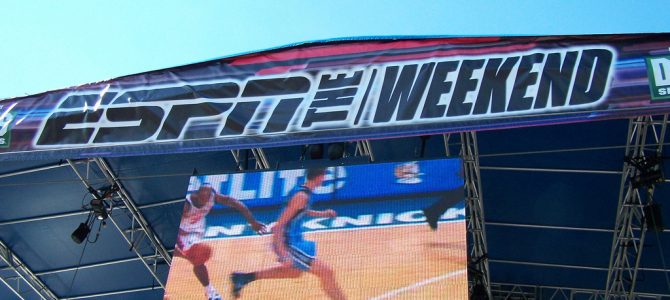
ESPN, the self-proclaimed worldwide leader in sports, became the worldwide leader in sports layoffs on Wednesday morning after news leaked that the cable network was in the process of laying off 100 staffers, most of whom are reported to be on-air talent.
The layoff reports came as no surprise to those who have followed ESPN and its on- and off-air struggles to profitably provide the kind of content that most sports fans want to watch. Shortly after the mass layoff reports were confirmed, the Internet hot takes began. ESPN is failing because of cord-cutting, because it has too much politics, because it has too little politics, because sports fans are racists, you name it.
So what’s the real reason the network felt forced to slash its payroll overnight? There is no one reason. There are a number of factors, each of which has been multiplied by poor strategic decisions. ESPN would have you believe that the network is a victim of circumstances, caught up in an industry whirlwind over which it has no control. Maybe, but that’s hardly the whole story. The real reasons aren’t all that complicated, but they’re not as simple as much of the social media hand-wringing would have you believe.
ESPN isn’t struggling because of one thing. It’s struggling because of a bunch of different things happening simultaneously. Some are outside of its control, and some are not. Here are the big reasons for these mass layoffs.
1) ESPN Overpaid for Broadcast Rights
In a nutshell, ESPN committed to paying massive long-term fixed costs for the right to air professional sports events, namely NFL and NBA games. Sports reporter Clay Travis of Outkick has been banging the drum on this score for quite some time, much to ESPN’s chagrin (Just last month Travis predicted Wednesday’s mass layoffs only to have ESPN sic its PR hounds on him and accuse him of making it all up).
In accounting terms, the network committed to high long-term fixed costs (broadcast rights) in exchange for declining variable revenues (cable subscription fees and advertising dollars). You don’t have to be a mathematician to see the problems with this formula for success. Even if ESPN is making decent money right now, the music is eventually going to stop, people are going to stop dancing, and somebody’s going to be stuck without a chair.
Here’s how Travis sums up the problem:
The simple truth of the matter is this — ESPN spent way too much on sports rights just as its cable and satellite subscriptions began to collapse. On track for $8 billion in programming costs in 2017, ESPN will rack up its 15 millionth lost subscriber since 2011. Every single day so far in 2017 over 10,000 people have left ESPN. The numbers are astonishing and the collapse is rapid. All those lost subscribers add up to big money — that’s over $1.3 billion a year in money that comes off ESPN’s books every year. And ESPN is on the hook for billions and billions a year for all the years ahead. That’s guaranteed payments to leagues that ESPN can’t escape no matter how many employees it fires.
As I’ve written before, if the current subscriber loss trajectory keeps up ESPN will begin losing money by 2021. And if the subscriber losses accelerate it will happen even sooner than that.
Rising fixed costs and risky, declining revenues are the root of all of ESPN’s problems. Overpriced broadcast rights are certainly the biggest piece in that financial puzzle, but they’re not the only one. Salaries are also a pretty heavy fixed cost, and one the network decided to slash. Will that decision improve the financial picture, at least on the costs side? Maybe. But ESPN could fire every single person on staff and still not make the numbers work. When your ship is sinking, tossing a few deck chairs over the side isn’t going to accomplish much.
We’ve identified and addressed ESPN’s main cost problem. But what about its revenue problems? What is causing those?
2) Cable Cord-Cutting
ESPN is hemorrhaging subscribers. There is no debate about this fact. In just the last six years, the Connecticut-based sports network has lost 12 million subscribers. At roughly $7 paid out monthly to ESPN per subscriber, that’s nearly $100 million in lost revenue each month going forward for eternity. The big question is: Why are those viewers no longer choosing to pay for cable, and by extension choosing to pay Disney for the privilege of having ESPN on their cable box? Is it because they’re tired of paying for cable, or because they’re tired of paying for ESPN?
ESPN and Disney executives will tell you it’s obviously the former and has nothing whatsoever to do with ESPN. The Internet has changed things, they’ll say, and services like Hulu, Amazon, and Netflix have made cable, and its exorbitant monthly fees, less necessary.
There’s clearly some truth to this. Cord-cutting is a sweeping dynamic, and ESPN just happens to be the biggest chunk getting pushed into the dustpan. But ESPN’s public rhetoric about cord-cutting having nothing to do with ESPN completely contradicts the corporation’s rhetoric about negotiating fees from and services to cable providers.
That’s because Disney, ESPN’s parent, uses the popularity of ESPN’s live sports programming to force cable companies into carrying and paying for a large swath of less popular Disney-owned networks. The message? If you want ESPN, then you’re not only going to pay Disney for it, you’re also going to pay for A&E and Lifetime and Lifetime Movie Network and History and Freeform and Disney Junior and Disney XD and Vice. It doesn’t matter if you don’t plan to watch a second of any of those networks: if you want to watch college football for three months in the fall, you’re going to pay for the unrelated also-ran networks whether you like it or not.
ESPN knows people will pay for cable just to get ESPN, hence its near-extortion of cable companies into carrying myriad other Disney-owned channels. Given this fact, how can ESPN claim that cord-cutting has nothing to do with ESPN? If people are plugging the cord in just to get ESPN, then you can pretty much guarantee ESPN is very much a part of the cord-cutting conversation. ESPN can’t have it both ways.
Is a ton of cord-cutting happening regardless of what ESPN’s doing? Absolutely. Is the network a mere blameless bystander in the cord-cutting? Not at all. If ESPN wants to claim responsibility for bringing people into the cable fold, then it must also take responsibility when a diehard sports fan finally decides that ESPN’s just not worth the cost of cable anymore. This brings us to the next cause of these revenue problems.
3) Declining ESPN Ratings
ESPN isn’t just losing millions of cable subscribers, many of whom probably never even watched the network despite paying for it. It’s also losing viewers. According to Broadcast & Cable, a TV industry trade publication, ESPN’s ratings are down 7 percent this year, and ESPN2’s ratings are down a whopping 34 percent. What gives?
If you talk to sports fans and to people who have watched ESPN religiously for most of their lives, they’ll tell you the problem is the lack of sports and a surplus of shows featuring people screaming at each other. The near-universal sentiment of former ESPN addicts I’ve spoken to is that the content provider sidelined actual sports in favor of carnival barkers. Sure, you clicked over to ESPN to watch sports, but what you’re actually going to get are “Crossfire”-esque segments of non-athletes making dumb arguments about topics you don’t care about.
One industry insider told me that it’s as if network executives looked at the popularity of local and regional sports talk radio and decided that ESPN needed to replicate that model on television to be successful. If that’s what they actually thought, they were wrong.
Passively listening to a radio show while you’re at work or in your car and unable to watch a live game is a very different thing than wanting to watch some game highlights during the whopping 30 minutes of free time you have to do nothing at home each night. The two aren’t perfect substitutes for each other, yet ESPN’s programming decisions suggest the network thinks talking heads are as big a draw as actual athletes competing on the field. And all this after spending $8 billion to get the rights to air those competitions?
It’s madness. ESPN went from the worldwide leader in sports to yet another expensive network of dumb people yelling dumb things at other dumb people, all the while forgetting that the most popular entertainment form of people yelling about sports stuff for several hours a day — sports talk radio — is free. This brings us to the final major reason for ESPN’s current predicament.
4) Politics
With all this in mind, it’s not at all surprising that ESPN decided to retreat into the fever swamp of leftist politics to save itself. An obsession with politics didn’t doom ESPN, but it’s going to make it extremely difficult for ESPN to dig itself out.
The industry insider I spoke to said the focus on politics was a symptom, rather than a root cause, of all these current issues. According to this insider, ESPN executives saw the writing on the wall — higher costs, subscriber losses, lower ratings — and decided that it needed a bigger content pie to attract more content consumers. Sports is too small, so why not try for a real mass audience by broadening the network’s focus to include news and politics? If X number of people like sports, and Y number of people like politics, then surely combining sports and politics will lead to a much bigger audience, thereby solving the company’s financial dilemma.
This view, of course, ignores how people consume political news. The diehards who love political news don’t turn on the TV or open the laptop and navigate to sites with zero bias that just play it straight. Why? Because those kinds of political news and commentary providers don’t exist. Because that’s not what political junkies want. Liberals want news from liberals, and conservatives want news from conservatives. The Balkanization of political news and commentary didn’t happen by accident. People in this business know you have to pick a side. That works in political news. It doesn’t work if you have a bipartisan mass media audience.
Instead of expanding its pie by combining two types of mass media content, ESPN ended up communicating to half its audience that it didn’t respect them. How? By committing itself entirely not to political news, but to unceasing left-wing political commentary.
You want to watch the Lakers game? Okay, but first you’re going to hear about Caitlyn Jenner. Want some NFL highlights? We’ll get to those eventually, but coming up next will be a discussion about how North Carolina is run by racist, homophobic bigots. You want to see the box scores of today’s baseball games? You can watch those at the bottom of the hour, but right now some D-list network talent would like to lecture you about gun control. After that we’ll have a panel discussion about how much courage it takes to turn your back on the American flag.
The most interesting aspect of the mass layoffs on Wednesday isn’t that they happened, it’s who the network targeted. Not the high-priced carnival barkers and the know-nothing loudmouths doing their best to make Rachel Maddow proud. Nope. ESPN targeted sports reporters. In an effort to cut some fat from its bottom line, ESPN exchanged a scalpel for a chainsaw, skipped the fat entirely, and went straight to cutting out muscle.
If ESPN wants to once again be the worldwide leader in sports, it should refocus on covering sports, which used to be a refuge from politics and the news. America is politicized enough already, and if its citizens want political news, several cable outlets do political news far better than ESPN ever could. Instead of doing sports and politics poorly, perhaps the network could return to the thing that it used to do better than everyone else in the world: cover live sports.









